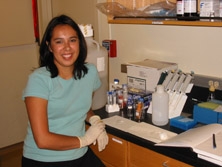
School:
Grade Level:
Teaching Position:
Supervisor:
Department:
Mentor:
Research Project Year:
Research Project Title:
Research Project Description:
Many of today's biosensor applications are costly, time consuming and sometimes unreliable. A quick, highly sensitive and selective process is needed to detect specific biological and chemical molecules. It has been found that conjugated polymers and oligomers are highly responsive fluorescent reporters for biosensor applications. However, their efficacy is dependant on their environmental conditions. My role was to measure the signal intensity of different poly phenylene vinylene (PPV) polymers in various conditions. Utilizing the fluorimeter, I measured quenching rate constants in buffer and compared the results to those found in water.
Research Project Attachments:
| Attachment | Size |
|---|---|
| 279.23 KB |
Curriculum Project Year:
Curriculum Project Title:
Curriculum Project Description:
This lesson plan has been designed for high school Physics and or Earth Science students. Four Physics, one Earth Science and all of the Investigation and Design California State Content Standards will be addressed. The projected timeline is 30 weeks. Students from two different high schools will design and implement a long term, collaborative, inquiry investigation through guided inquiry. In addition, they will co-author a scientific research paper not to exceed 25 pages. Students will investigate which factors are directly correlated with the rate of seasonal beach variation. Before they begin their investigation they must have an accurate picture of how research is conducted in the scientific community. To achieve this goal they will participate in a variety of activities that include, examining scientific research papers, communicating through the Internet with scientists and a field trip to the American University of the Caribbean to discuss with professors the process they use to conduct research. Before the project is introduced students will learn the necessary vocabulary associated with the inquiry project. Using this knowledge coupled with their understanding of the process of scientific investigation they will be guided to design the correct methodology for this experiment. The students will then collect data once a week for 18 weeks. Each high school will alternate collecting weekly data. They will share the collected data through Internet web boards set up for this specific investigation. At the end of the study, the two high schools will write a collective scientific paper in a jigsaw fashion. Finally, the completed scientific research paper will be published in the local newspaper.
Curriculum Project Attachments:
| Attachment | Size |
|---|---|
| 335 KB |
